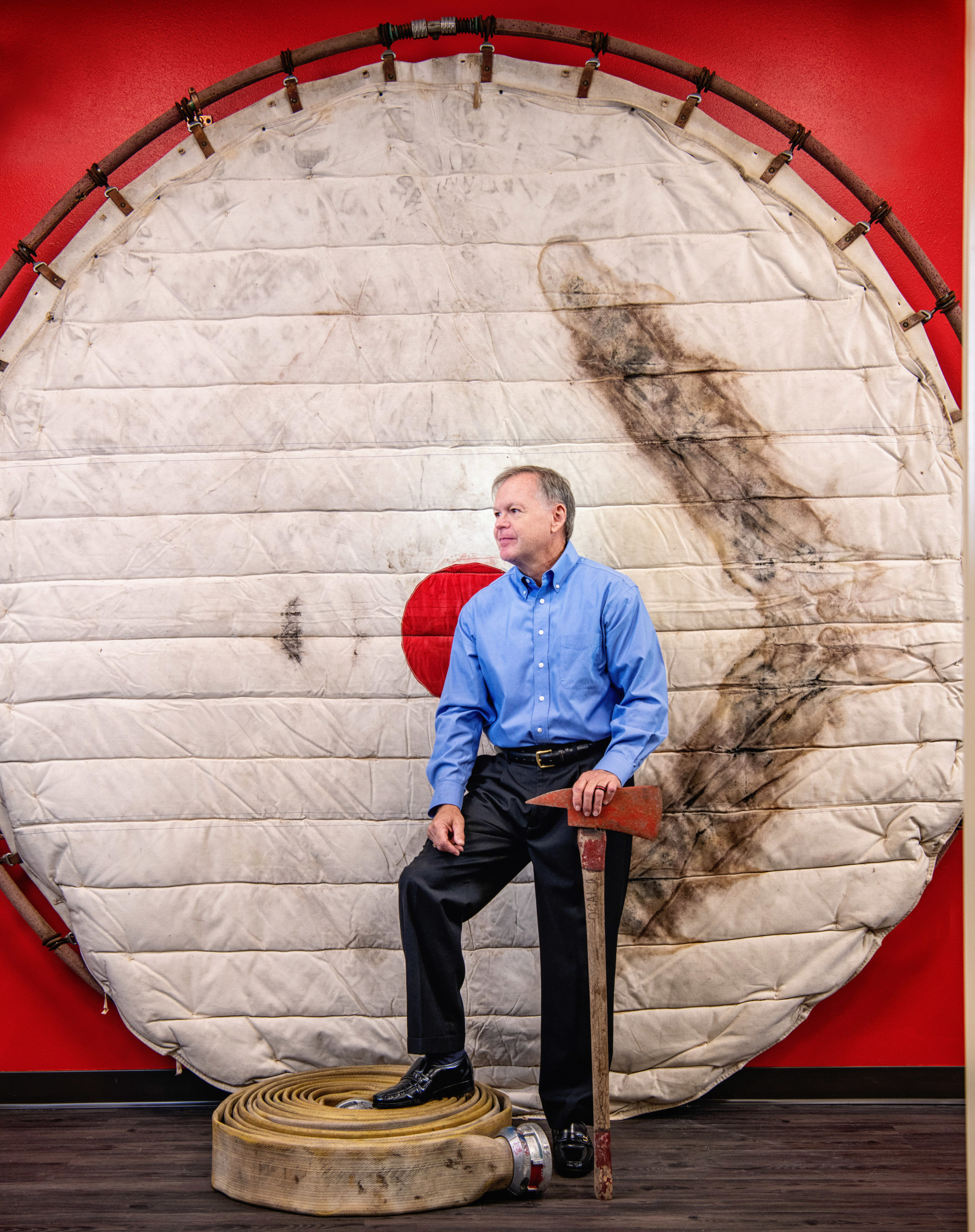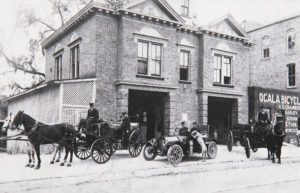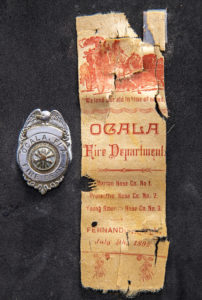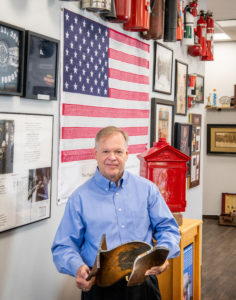Brian Stoothoff
Meet the researcher and collector primarily responsible for organizing the impressive Ocala Fire Museum.

In 1827, Fort King was constructed east of present-day Ocala. Marion County was established in 1844, with Fort King as the county seat. In 1846, Ocala became the county seat. The city consisted of a sprawling 80 blocks around a public square, with mostly wooden structures ranging from homes to businesses to hotels.
On Thanksgiving Day 1883, a fire began to rage at the Benjamin & Company Store and quickly spread. The inferno consumed buildings over an area spanning about five blocks.
After the disaster, some residents were inspired to lobby for an organized fire brigade. Fire bonds were sold to raise funds and, by 1885, Ocala had its first fire department. The rebuilding effort also brought the town the nickname of Brick City.
The 137-year history of the fire department can now be explored through the Ocala Fire Museum, located at the city’s first responder campus at 505 NW Martin Luther King Jr. Ave., which also houses Ocala Fire Rescue (OFR) administration offices and Fire Station 1, an Ocala Police Department substation, a basketball court and a community room.
The museum has been a labor of love for more than three decades for former OFR Assistant Chief Brian Stoothoff. It also is the perfect endeavor for a man who has an abiding appreciation for firefighting as a career and a staunch commitment to preserving history, which is also carried out through his involvement with the Historic Ocala Preservation Society.
Amassing Memorabilia
Stoothoff grew up on Long Island in New York. As a child, he loved history and traveling. His father was a New York City firefighter and Stoothoff says he grew up knowing it was a noble profession but not “initially on my radar” as a career.
Stoothoff moved to Ocala in 1978 to attend college “and enjoy the Florida weather.” He graduated from what was then the Central Florida Community College and later from the University of Florida (UF).
 “It was while I was attending UF that I realized accounting might not actually be the best profession for me,” he recalls. “I wanted to do something with my life that was truly exciting, and I really liked the idea of helping people in their time of need. Thus, I enrolled at the fire college.”
“It was while I was attending UF that I realized accounting might not actually be the best profession for me,” he recalls. “I wanted to do something with my life that was truly exciting, and I really liked the idea of helping people in their time of need. Thus, I enrolled at the fire college.”
After he graduated from the Florida State Fire College in 1982, he began working for the City of Ocala as a firefighter/emergency medical technician. Soon after, he obtained certification as a paramedic.
As a new firefighter, Stoothoff shares, “The fire chief, me being the new guy, would say, ‘Go clean out the attic and throw stuff out.’ But I couldn’t throw it out.”
Eventually, he amassed a huge assortment of memorabilia.
“As an avid researcher, I have been reading and learning about the history of the fire service since I became a firefighter. I have visited fire museums and fire stations throughout the world and have learned something from each one,” he shares. “Although originally it was not my intention to be the curator of a fire museum, in retrospect it was probably inevitable given my interest and growing collection of memorabilia. The Ocala Fire Museum was made possible due to support from city management and fire administration. Olivia Ortiz helped me in creating the first museum, which was in the prior fire administration building.”
 Ortiz is married to OFR Capt. Anthony Ortiz. She knew Stoothoff had collected a lot of material and when she saw it, she told him, “You have enough stuff to do a museum.”
Ortiz is married to OFR Capt. Anthony Ortiz. She knew Stoothoff had collected a lot of material and when she saw it, she told him, “You have enough stuff to do a museum.”
“And he said, ‘I was hoping you might want to help me,’ and I said, ‘Sure,” she remembers. “He had so much cool stuff. It started out with a little display case at Station 1 and then we worked on it for a year and half, two years, and by the time you knew it, we had a whole dang fire museum.”
The Museum
Firefighters have contributed the majority of the items in the museum, but some were donated by citizens.
On a recent morning, Stoothoff received a visit from Ocala native Patti Jo Lynn, whose father Chuck Spray was fire chief in the 1970s and ‘80s. She donated a full-page article printed in 1962 in the Ocala Star-Banner, which pictured her father and discussed safety on the water during summer vacation.
“I decided to donate this because I thought everybody should see it,” Lynn offers. “My daddy was a member of search and rescue. He would go and save a lot of people. I’m very proud of my dad.”
Stoothoff says the museum organizers are grateful for the thousands of artifacts that are now on display.
“Some of the museum’s oldest items date back to the 19th Century,” he marvels. “I have two favorites: the oldest item and one of the newest acquisitions. The oldest is the only known fireman’s badge that still exists, which dates from the 1880s. Although the name of the wearer is unknown, I envision that person was physically fit, brave and had a desire to help other people; similar traits to those who wear a badge today.
“The other item special to me,’’ he continues, “is a piece of severely distorted steel from the collapse of the World Trade Centers on Sept. 11th, 2001. I was able to obtain the 40-pound steel segment from the Port Authority after visiting New York. Sadly, 343 FDNY firefighters died that day, but to me it represents the commitment that first responders make every day to help others, even in the face of grave danger.”
The Ocala Fire Museum is designed to be viewed as a progressive timeline.
“These are some of our earliest artifacts,” Stoothoff says, pointing to one wall as a starting point. “This is an original photo from 1891. It has all the firemen’s names on it. It was photographed on the downtown square. You know where the new hotel is? Well, there’s been a hotel there since 1846. This shows the firemen in front of it and how they pulled the fire hose cart by hand.”
Pointing to a large piece of engraved marble, he adds, “This came out of the fire station that was downtown, where the parking garage is today. It was constructed in 1894, of brick.”
A few feet away, he indicates a segment of the brass sliding pole from that station.
Bringing attention to a framed newspaper article, he continues, “Ocala burned down in 1883, on Thanksgiving Day. It burned five square blocks downtown, including the newspaper office. So, they sent a rider on horseback to Palatka, which was the nearest printing press, and this was printed two days later. This is a copy of the Ocala Banner, which became the Ocala Star-Banner, and it describes the great fire.”
Stoothoff says post-fire efforts raised enough money to form the fire department and to build three fire stations. Numerous historic photographs document those buildings, and subsequent ones, along with the faces and names of the firemen of the time.
Among the earliest artifacts is a fire rattle, a wooden device that emits a shrill grating noise when activated by hand. Over time, the rattles were replaced with fire alarm boxes, and there are several, all painted bright red, in the museum.
“In the 1800s, there was no telephone, there was no way to report a fire, other than the rattle, so they started to install fire alarm boxes,” he says. “Ocala had ones just like this on the downtown square.”
Fire alerts also came in the form of fire bells. A massive one was part of the station built in Ocala in 1894. That bell, manufactured in 1889 in Baltimore, is now mounted for public viewing near the Institute of Human and Machine Cognition campus in downtown Ocala.
Among the varied displays in the museum are competition ribbons from the late 1800s, receipts from organizations the fire department did business with back in the 1920s and ‘30s, fire department patches and helmets from around the world, and a handful of mounted metal plaques that pique interest.
“Back in the 1800s, when you had fire insurance on your home, you would mount one of those to your house,” Stoothoff notes. “If the fire department showed up and you didn’t have an insurance plaque, they didn’t put out your fire.”
Along with several fire hydrants, there is a section of an old wooden log.
“Back in early 1800s, they would take a log pole and hollow it out and that was your water line,” Stoothoff says. “In the event of fire, they would dig down through the dirt and puncture the log to get water for the fire hose. After the fire, they took a wooden plug and plugged it back up, which is why we still call them fire plugs today.”
One display, which he calls a “pretty neat find,” is a hose table, which stands on a spindle about 4 feet high and has a rotating wooden top that is supported by a wooden wheel spoke and is used as a platform on which to wind up the heavy fire hoses.
“For years we used this; never really gave it any thought,” Stoothoff reminisces. “When I saw this one day by chance, I thought, ‘This is really old.’ I found a newspaper article from 1933, where the firemen hand-built this. I believe it’s a wheel from a chief’s decommissioned vehicle. It works just as fine today as when it was made,” he says, grinning as he gives it a spin.
One of the largest items on display is a life net, which would have been used to catch someone jumping from a structure. Other artifacts include early medical equipment and rare fire extinguishers, toys, fire suits and memorabilia from a fire at a church.
“The largest fire I know of in Ocala, other than the great fire, was an arson fire at the First Baptist Church in 1991… a guy burned 23 churches in the southeastern U.S.,” he offers. “He is still serving time in federal prison.”

Past And Future
Marion County’s resident movie star John Travolta is featured in a fire museum display with a poster and autographed script from the film Ladder 49, starring him and Joaquin Phoenix.
And speaking of movies, Stoothoff also has put his affinity for historic research to work in documenting films made in Ocala, including It’s The Old Army Game, a 1926 silent comedy starring W.C. Fields and Louise Brooks.
“It was filmed almost entirely in Ocala,” he says. “It has the fire department in it. You can see the fire alarm box like we have here. There are scenes in what is now Harry’s. You can see the old courthouse, old hotel. It’s a fabulous movie.”
As for how he feels about being a documentarian and history keeper, Stoothoff says he considers himself fortunate to appreciate the past.
“I have been described as being detail oriented, which makes this passion as a historian easy and enjoyable for me,” he expresses. “I believe the world is a better place when we do something well that enriches the lives of others. I am grateful I have been surrounded by good friends and a supportive wife, and that I have been given the opportunity to create a wonderful exhibit for the citizens of Ocala and visitors to our community to explore.
“I believe for a while, certain stories may be passed along to others verbally; however, often with time, the message can get distorted, or even worse, may get lost forever,” he adds. “Conserving, preserving and maintaining the history of the fire service promotes an understanding of the similarities and advancements the profession has made during the past two centuries. The Ocala Fire Museum helps inspire and educate people. It tells a story and helps preserve history for future generations. Who knows? Perhaps a child who visits the museum will one day become one of our hometown heroes.”
OFR Chief Clint Welborn concurs.
“In a profession where traditions are upheld and progress is largely obtained through lessons learned,” he offers, “I believe that preserving and sharing our history is of utmost importance.” OS
Entry to the Ocala Fire Museum is free and open to the public 8am to 4pm Mondays through Fridays. To request access, call (352) 629-8306. To learn more about Ocala Fire Rescue, go to ocalafire.org






